Crime Awareness
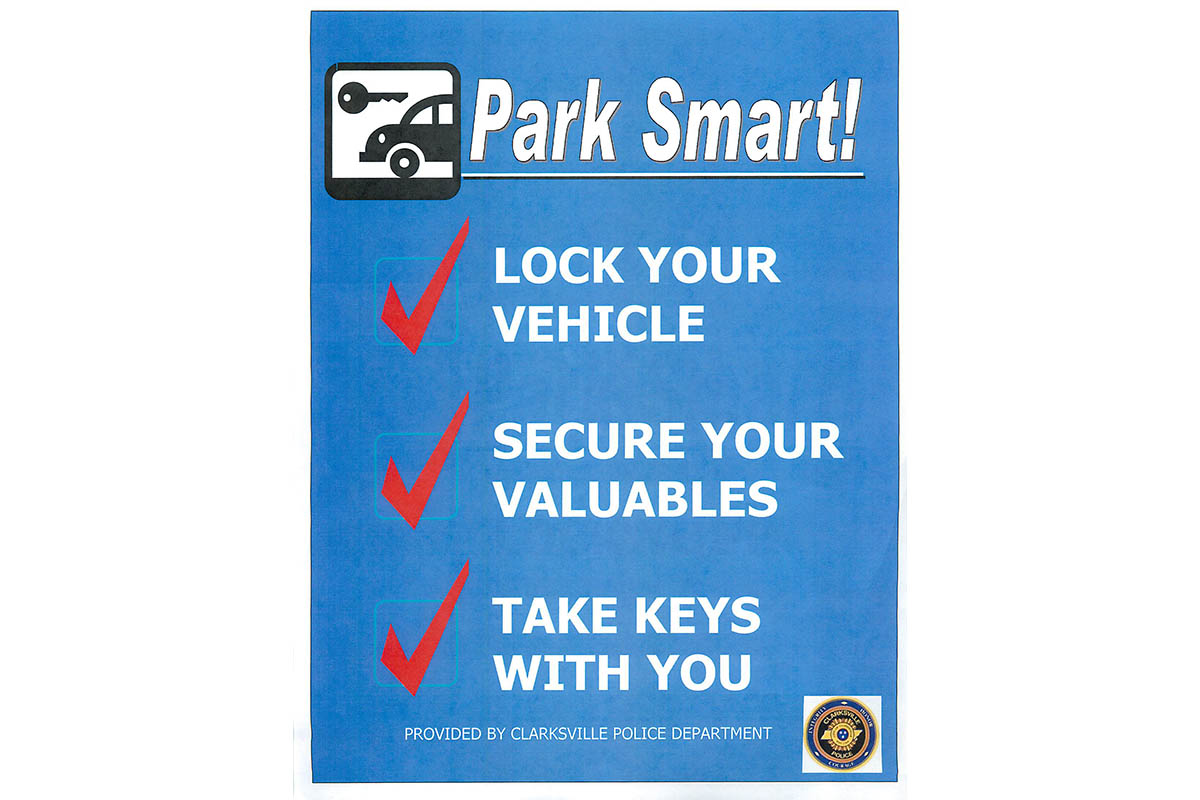
Vehicle Burglaries
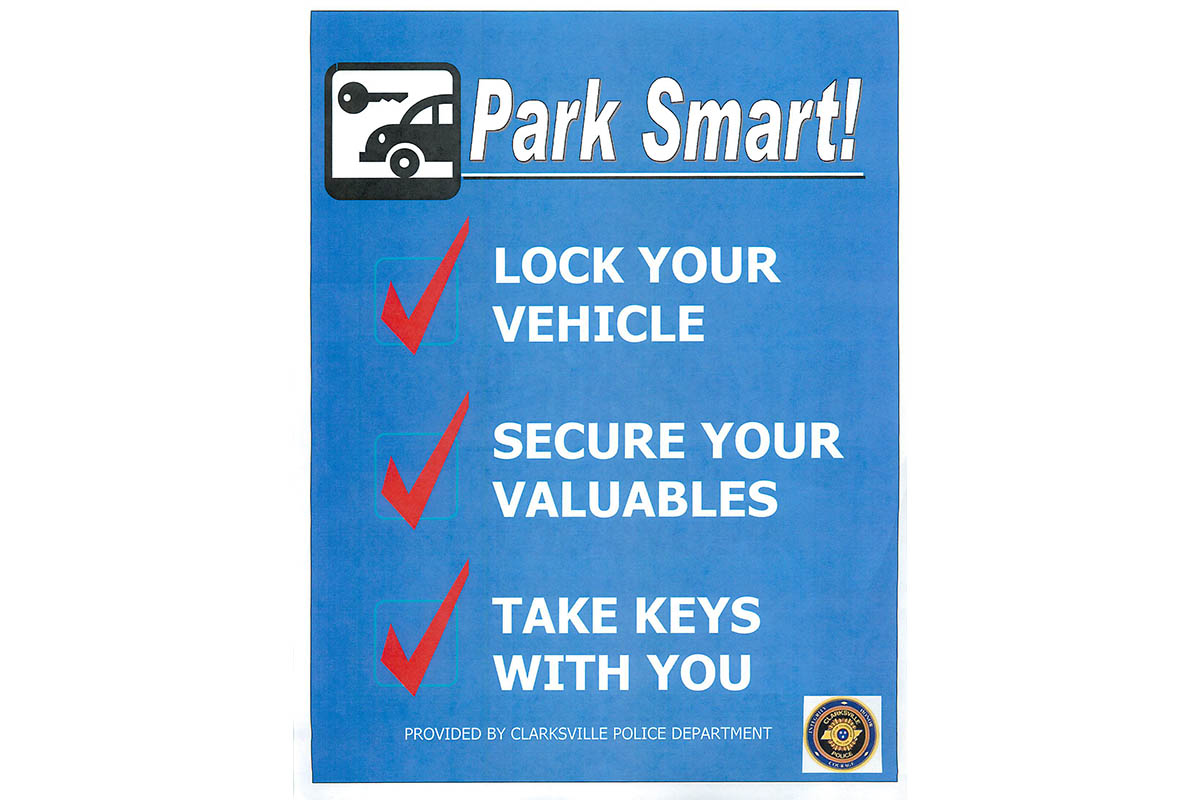
PARK SMART/SHOP SAFELY CLARKSVILLE
“We review our crime statistics weekly, and the thing that stands out is so many of the break-ins and thefts occur because people leave their cars and homes unlocked, and many times valuables such as purses, electronics, and merchandise are left in plain sight,” Mayor Pitts said. “I encourage citizens to beware and take some simple preventive measures to reduce the probability of becoming a victim.”
SAFE SHOPPING
Clarksville Police say a first step, whether residents are out shopping or pulling into their driveway, is to “Park Smart.” This includes three easy steps:
-
Lock your vehicle.
-
Remove or secure valuables.
-
Take your keys with you.
Clarksville Police also say firearms should never be left in a vehicle. Also, drivers should not leave a vehicle running, and children should not be left alone or unattended in a vehicle.
TIPS FOR SAFE SHOPPING
Common sense precautions make for safe and successful shopping. First, dress casually and comfortably and avoid wearing expensive jewelry. Shop with a friend, and watch out for each other. Shop during daylight hours, if possible.
Secure wallets or purses so they cannot be grabbed or lifted. Put the purse strap over your body, and your wallet in a front pocket, for example. Also, don’t carry large amounts of cash; safeguard your credit cards, and protect your PIN when you use a keypad.
Park in well-lit areas, and make a note of the lot and row number to make sure you remember exactly where you parked. Avoid parking next to vehicles with tinted windows. Shoppers should have keys in hand for quick entry when returning to a parked car, and keep an eye out for suspicious persons or activity.
Keep packages and valuables out of sight. When your car is filled with goodies, do a home drop-off and then return for additional shopping.
PACKAGE DELIVERIES
Online shopping creates deliveries, and the holidays bring out porch thieves who comb neighborhoods looking for packages.
Police urge these steps: Track deliveries by using email notifications. Have the package picked up or delivered to a friend or relative who is available at delivery time. If possible, have deliveries sent to your office or workplace, or have them shipped to a location where the package can be held for pick up.
AFTER THE GIFTS ARE OPENED
Don’t advertise what you bought or received by leaving boxes at the curb. Break down boxes and dispose of them quickly. Use caution on social media -- don’t post about the great gifts you received.
TRAVELING FOR THE HOLIDAYS
Prepare for your departure. Have someone you trust to check on your house while you’re gone. Stop or have your newspaper or mail picked up. Set an automatic timer for your lights and consider a timer to turn on a TV or radio to make it sound like someone is home. Set alarms and double lock doors.
Home Burglaries
More than three million burglaries committed in the United States in 1996 accounts for 24 percent of the reported serious crime. About 66 percent of all burglaries, or approximately two million, are committed in houses and apartments. About 69 percent of all burglaries required forcing a door or window to gain entry. Most houses and apartments are protected by simple and ineffective door and window locks. Modern hardware is available for door and window locks which will stop the amateur and slow up the experienced burglar.
There are generally three types of burglars: the professional, the semi-professional, and the amateur. Although the average homeowner will probably not have to face professional thieves who focus on extremely valuable items, you need to be aware of the semi-professional and amateur burglars.
Residential burglars are often male teenagers who live near your home. They are opportunists who look for easy targets. If the risk of detection is too high, the average burglar will not attempt to enter your home.
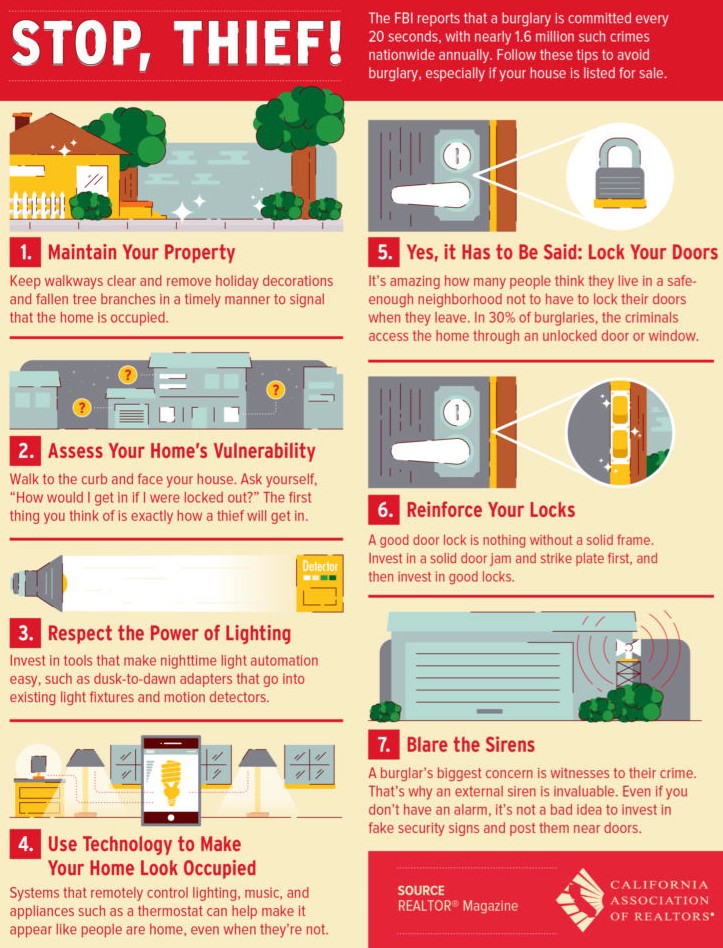
How to Protect Your Home
Overgrown or extremely large trees or shrubs can hide burglary activity, especially around your home entry points. For security's sake, have them trimmed or moved.
Fences can be an effective part of your security, but they may be a liability in hiding a burglar's privacy. Tall chain linked, fences provide security without sacrificing visibility.
Dogs can also be a valuable asset to homeowners. Any dog that bark at strangers brings unwanted attention to a thief. Larger dogs can even discourage an intruder from entering your yard or home.
Street lights are another important crime deterrent for your neighborhood, but personal residence should be well lighted. Porch lights and motion-sensitive lighting are recommended for most homes.
You do not want to help a burglar break into your home, so watch what you leave in your yard. Be sure to put tools away after you are done. Your own ladders, screwdriver, hammers, or pliers can be used against you.
The average burglar has only two options for entering your residence: doors and windows. For external door frames, opt for solid wood or steel. Hinges should be positioned on the inside of the door so that a thief with a screwdriver will be unable to remove the entire door. Deadbolt locks are a necessary investment. Sliding glass doors are a common entry point. For maximum security, use vertical bolts. Also, place a solid wood rod on the inside track to hold the door closed.
Garage doors are another frequent entry point. The door that connects your garage to your home should have solid wood or solid core construction. Secure it with a deadbolt lock. Don't rely on the electric garage door opener as your security measure. When you are leaving, take a few seconds to watch the door close completely.
Back doors are a popular target because they are offer concealment from the street and owners leave them unlocked. It's important to keep your door well lighted and install a deadbolt. These doors should have a solid core as well.
All ground windows should have key-operated sash locks. Keep your windows closed and locked when you are away. Screen and storm windows should be securely fastened to the structure.
Upper windows should be secured and locked. Keep your second floor secured by trimming tree branches away from the house to prevent climbing, and do not store ladders where burglars can use them.
When you move into a new house, apartment or condominium, change all of the locks immediately. Because keys have a tendency to multiply, you don't know who will have access to your home.
Talk to your neighbors about your concern about burglary. Ask them to report any suspicious persons or activities around your home to your law enforcement agency. Alarms on doors and windows are the surest way to detect a burglar, but watchful neighbors alert to unusual activity who will notify law enforcement authorities are an effective means of detection.
Vacationers provide burglars with plenty of time to enter your home, remove large items, and search leisurely for hidden valuables. If you are planning a vacation, take precautions to protect your home. The key is to create an illusion of everyday activity. Ask the police to check your home and patrol your neighborhood while you are away. Stop the mail and newspaper deliveries, or have your neighbor collect them while you are away. Secure all doors and windows, pet entrances, and garage doors. Transfer all valuables to a safety deposit box. Place a timer on indoor and outdoor lamps to illuminate your home at night, and make sure that no blobs are burned out. Have a trusted friend or neighbor check your home each day. Never indicate on your phone answering machine that you are on vacation.
If you want advice or assistance for your home or your neighborhood, contact the Lafayette City Police Department. You don't have to be one of the more than 2 million residential burglary victims and neither do your neighbors. Remember. Crime prevention begins at home.
Drug Use and Gang Activity
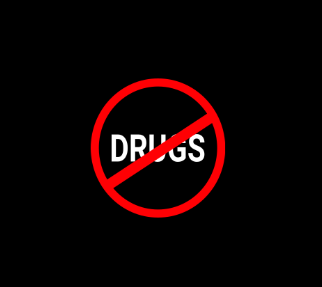
|
NEED ANSWERS? Below you will find information on Signs of Drug Use and Gang Activity |
Illegal Drugs Come In Many Forms And Their Effects Can Vary Significantly
There is a very long list of common illegal drugs that are used and abused all over the United States and we will review the top 10 illegal drugs.
There are different types of schedule drugs such as schedule I and II that have a higher potential for misuse.
Some of these types of schedule drugs are either unavailable to the public, are only available by prescription, but are limited to no refills such as Schedule III and IV drugs.
Effects of illegal drugs not only are changing individual’s well-being but also the nation. With the rise of opioid abuse, the effects of illegal drugs are making waves in communities and all over the nation.
Here we’re going to discuss the top 10 illegal drugs and their effects.
Common Illegal Drugs
Common illegal drugs fall into a few different categories and then within each of the categories, there are certain substances that are used more than others.
These categories are:
• Cannabinoids – These types of substances aren’t illegal everywhere. They are either smoked or swallowed and create a euphoric, relaxed state for the individual.
• Opioids – These types of drugs are injected, smoked, swallowed, or snorted and are classified as Schedule I, II, III, and V drugs. They create euphoria and drowsiness as well as impairment.
• Stimulants – Stimulants are one of the more common illegal drugs that are Schedule II substances. They are snorted smokes, injected, and swallowed. They not only increase heart rate but also blood pressure and body temperature.
• Club Drugs – Club drugs are another type of common illegal drug, popular within certain age groups. They are schedule I and IV substances that can be swallowed, snorted, or injected, and depending on the substance create different effects. These effects range from hallucinogenic effects to lowered inhibition to sedation and memory loss.
• Dissociative Drugs – These illegal drugs are either not schedule drugs or are Schedule I, II, or III. They can be chewed, smoked, injected, snorted, and swallowed depending on the substance. As party drugs, they create a wide range of effects on the body but in general a feeling of being separated from one’s body hence; dissociative.
• Hallucinogens – Hallucinogens are swallowed, smoked, and absorbed through mouth tissues, such as LSD. They are Schedule I drugs that create an altered state of perception.
• Other – These can be steroids or inhalants that are either a schedule III or not scheduled substance that has very little effects on the mind but can create side effects for overall health.
Schedule I and II drugs are considered to be drugs that have a high potential for abuse and are stored in secure locations and are usually used for research.
Schedule II drugs are available for a non-refillable prescription. Schedule III and IV drugs can be administered via prescription and can be given up to six months of prescription. Schedule V drugs can sometimes be found over the counter.
Top 10 Illegal Drugs and their effects
The effects of illegal drugs on the body vary from substance to substance and may even be life-threatening if they are habit-forming and cause addiction.
The top 10 illegal drugs are:
1. Marijuana – Creates slowed reaction time, euphoria, relaxation, and increased appetite. (Not illegal in every state)
2. Heroin – Euphoria, drowsiness as well as impaired coordination and slowed breathing.
3. Cocaine – Nasal damage, increased heart rate, and blood pressure, as well as increased energy and mental alertness.
4. Methamphetamine – Can cause severe dental problems, increased heart rate, blood pressure, anxiety, and mental alertness.
5. MDMA – Can cause sleep disturbances, depression, impaired memory, addiction as well as increased tactile sensitivity and lowered inhibition.
6. Ketamine – Can impair memory, cause delirium as well as create a feeling of being separated from one’s body.
7. LSD – Can increase body temperature and heart rate as well as create an altered state of perception and hallucinations.
8. Steroids – These create no intoxication effects but can alter blood pressure and create blood clots and liver cysts.
9. Inhalants – can give individuals muscle cramps, depression, and memory impairment as well as stimulation and loss of inhibition depending on the chemical.
10. PCP and Analogs – Causes anxiety, tremors, numbness as well as psychosis, aggression, and violence.
Signs of Drug Use
Methamphetamines: "Wired," sleeplessness for days and weeks at a time, total loss of appetite, extreme weight loss, dilated pupils, excited, talkative, deluded sense of power, paranoia, depression, loss of control, nervousness, unusual sweating, shaking, anxiety, hallucinations, aggression, violence, dizziness, mood changes, blurred vision, mental confusion, agitation.
Cocaine: Impaired thinking, confused, anxious, depressed, short-tempered, panic attacks, suspiciousness, dilated pupils, sleeplessness, loss of appetite, decreased sexual drive, restlessness, irritability, very talkative, scratching, hallucinations, paranoia.
LSD (Acid): Dilated pupils, skin discoloration, loss of coordination, a false sense of power, euphoria, distortion of time and space, hallucinations, confusion, paranoia, nausea, vomiting, loss of control, anxiety, panic, helplessness, and self-destructive behavior.
PCP: Sometimes violent or bizarre behavior, suicide has often occurred, paranoia, fearfulness, anxiety, aggressive or withdrawn, skin flushing, sweating, dizziness, total numbness, and impaired perceptions.
Inhalants: Short-lasting euphoria, giggling, silliness, dizziness. Then come the headaches and full-blown "faintings" or going unconscious. Longterm Use: Short-term memory loss, emotional instability, impairment of reasoning, slurred speech, clumsy staggering gait, eye flutter, tremors, hearing loss, loss of sense of smell, and escalating stages of brain atrophy. Sometimes these serious long-term effects are reversible with body detoxification and nutritional therapy; sometimes the brain damage is irreversible or only partially reversible.
Heroin: Chemically enforced euphoria. "Nodding," which is a dreamlike state, near sleep, drifting off for minutes or hours. For long-time abusers, heroin may act like a stimulant and they can do a normal daily routine; however, for others, it leaves them completely powerless to do anything.
Marijuana: Compulsive eating, bloodshot red eyes that are squinty (they may have trouble keeping them open), dry mouth, excessive and uncontrollable laughter, forgetfulness, short term memory loss, extreme lethargy, delayed motor skills, occasional paranoia, hallucinations, laziness, lack of motivation, stupidity, the sickly sweet smell on body, hair, and clothes, and strong mood changes and behaviors when the person is "high".
Depressants (Tranquilizers and Barbituates): Decreased inhibition, slowed motor coordination, lethargy, relaxed muscles, staggering gait, poor judgment, slow, uncertain reflexes, disorientation, and slurred speech.
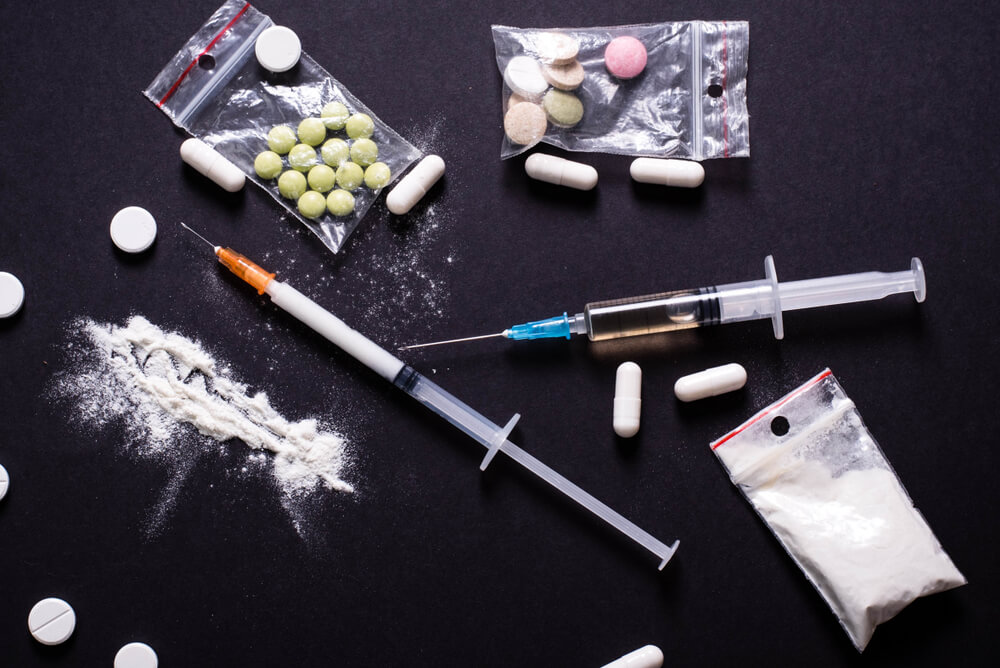
What is a Gang?
A gang is defined as an organization, association, or group of three or more persons, whether formal or informal, which has a common name and/or common identifying signs or symbols, whose members individually and/or collectively engage in criminal activity.
Why Do Kids Join Gangs?
- Identity through recognition
- Perception of belonging
- Peer pressure
- Intimidation
- Protection (real or perceived)
- Lack of family life
- Family ties to gangs (it is expected or acceptable to join a gang)
- Brotherhood/interpersonal bonding
- Low self-esteem
How Do Gangs Recruit Members?
Gangs influence youths into joining by using the following methods:
- Peer pressure offers protection
- Monetary enticements
- Challenging kids to take risks
- Invitations to parties where gang-related activities are occurring
- Family members already belong
- Affection and attention shown to the youths by gang members that may not be given at home
What Are The Consequences of Gang Involvement?
Short Term Consequences
- In trouble with law enforcement
- Drop-in performance at school
- Withdrawal from family
- Drug and alcohol involvement
- “Dirty work” for the gang, earning their “bones” or “stripes”
Long Term Consequences
- Loss of opportunities for education/employment due to a criminal record
- Time spent in jail or prison
- Possibility of losing family or friends
- Risk of personal injury or death
- Risk of family members’ lives
- Increased risk of violence in criminal activity
What Are Signs of a Gang in My Neighborhood?
- Graffiti
- Youths hanging out
- Increase in crime- Gang-related acts such as burglary, vandalism, and assaults.
How Can Neighbors Help?
You and your neighbors can work to eliminate gangs and drugs from your community and neighborhoods. The key is organization:
- Get to know the neighbors on your block.
- Contact your local law enforcement agency for advice and assistance for organization tips.
- Contact Crime Stoppers
What Are the Signs of Gang Involvement?
- Changes in attitude or behavior
- Openly admits gang affiliation
- Showing colors (bandanas, t-shirts, jackets, shoes, ball caps)
- Association with known gang members
- Unwillingness to discuss their activities
- Loss of family interest
- Reluctance to be seen with other family members
- Unexplained injuries (cuts and bruises)
- The trouble with law enforcement or at school
- Has unexplained cash or goods (clothing, jewelry, electronics)
- New Friends
- Tattoos or graffiti-style writing on clothing or books
- Disregard for persons or property
- Exhibiting signs of alcohol and drug use
How Can Parents Intervene?
- Spend quality time with your child.
- Encourage your child to become involved in athletics or other group activities that have adult supervision.
- Set reasonable rules and enforce them consistently.
- Demonstrate how to set goals.
- Monitor and support a child’s progress.
- Teach social skills that enhance self-esteem and how to cope with peer pressure.
- Educate the teen or child about the dangers of gang involvement.
- Provide a strong religious background.
- Keep an open line of communication with your child.
- Know your child’s friends and where they hang out.
- Keep track of your child’s work at school.
- Teens and children need to be involved in positive activities without a lot of leisure time.
- Keep them involved in after-school activities, athletics, or a job along with family time.

